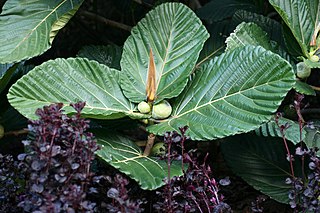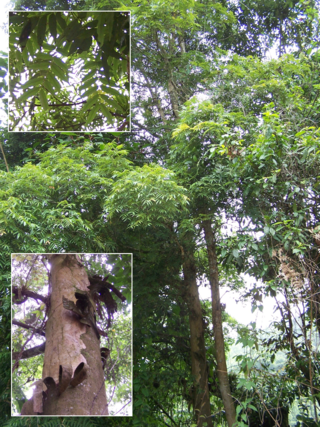
Ficus is a genus of about 850 species of woody trees, shrubs, vines, epiphytes and hemiepiphytes in the family Moraceae. Collectively known as fig trees or figs, they are native throughout the tropics with a few species extending into the semi-warm temperate zone. The common fig (F. carica) is a temperate species native to southwest Asia and the Mediterranean region, which has been widely cultivated from ancient times for its fruit, also referred to as figs. The fruit of most other species are also edible though they are usually of only local economic importance or eaten as bushfood. However, they are extremely important food resources for wildlife. Figs are also of considerable cultural importance throughout the tropics, both as objects of worship and for their many practical uses.

The Moraceae—often called the mulberry family or fig family—are a family of flowering plants comprising about 38 genera and over 1100 species. Most are widespread in tropical and subtropical regions, less so in temperate climates; however, their distribution is cosmopolitan overall. The only synapomorphy within the Moraceae is presence of laticifers and milky sap in all parenchymatous tissues, but generally useful field characters include two carpels sometimes with one reduced, compound inconspicuous flowers, and compound fruits. The family includes well-known plants such as the fig, banyan, breadfruit, jackfruit, mulberry, and Osage orange. The 'flowers' of Moraceae are often pseudanthia.

In botany, an inflorescence is a group or cluster of flowers arranged on a plant's stem that is composed of a main branch or a system of branches. An inflorescence is categorized on the basis of the arrangement of flowers on a main axis (peduncle) and by the timing of its flowering.

Ficus macrophylla, commonly known as the Moreton Bay fig or Australian banyan, is a large evergreen banyan tree of the Mulberry Family (Moraceae) native to eastern Australia, from the Wide Bay–Burnett region in the north to the Illawarra in New South Wales, as well as Lord Howe Island where the subspecies F. m. columnaris is a banyan form covering 2.5 acres or more of ground. Its common name is derived from Moreton Bay in Queensland, Australia. It is best known for its imposing buttress roots.

Ficus rubiginosa, the rusty fig or Port Jackson fig, is a species of flowering plant native to eastern Australia in the genus Ficus. Beginning as a seedling that grows on other plants (hemiepiphyte) or rocks (lithophyte), F. rubiginosa matures into a tree 30 m (100 ft) high and nearly as wide with a yellow-brown buttressed trunk. The leaves are oval and glossy green and measure from 4 to 19.3 cm long and 1.25 to 13.2 cm wide.

A raceme or racemoid is an unbranched, indeterminate type of inflorescence bearing flowers having short floral stalks along the shoots that bear the flowers. The oldest flowers grow close to the base and new flowers are produced as the shoot grows in height, with no predetermined growth limit. Examples of racemes occur on mustard, radish, and orchid plants.

Ficus benjamina, commonly known as weeping fig, benjamin fig or ficus tree, and often sold in stores as just ficus, is a species of flowering plant in the family Moraceae, native to Asia and Australia. It is the official tree of Bangkok. The species is also naturalized in the West Indies and in the states of Florida and Arizona in the United States. Its small fruit are favored by some birds. Ficus tree has shown to have environmental benefits in urban areas like being a biomonitor. The plant also has allergens associated with it.

Aralia spinosa, commonly known as devil's walking stick, is a woody species of plant in the genus Aralia of the family Araliaceae. It is native to eastern North America. The various names refer to the viciously sharp, spiny stems, petioles and even leaf midribs. It has also been known as Angelica-tree.

Ficus aurea, commonly known as the Florida strangler fig, golden fig, or higuerón, is a tree in the family Moraceae that is native to the U.S. state of Florida, the northern and western Caribbean, southern Mexico and Central America south to Panama. The specific epithet aurea was applied by English botanist Thomas Nuttall who described the species in 1846.
Ficus maxima is a fig tree which is native to Mexico, Central America, the Caribbean and South America south to Paraguay. Figs belong to the family Moraceae. The specific epithet maxima was coined by Scottish botanist Philip Miller in 1768; Miller's name was applied to this species in the Flora of Jamaica, but it was later determined that Miller's description was actually of the species now known as Ficus aurea. To avoid confusion, Cornelis Berg proposed that the name should be conserved for this species. Berg's proposal was accepted in 2005.

Ficus dammaropsis, the Highland breadfruit, locally called kapiak in Tok Pisin, is a tropical dioecious evergreen fig tree (subgenus Sycamorus, of the Mulberry Family with huge pleated leaves 60 cm across and up to 90 cm in length. on petioles as much as thirteen inches long and 1 in thick. These emerge from a stipular sheath up to fourteen inches long, the largest of any dicot. It is native to the highlands and highland fringe of New Guinea. It generally grows at altitudes of between 850 and 2,750 metres. Its fruit, the world's largest figs, up to six inches in diameter, are edible but rarely eaten except as an emergency food. There are two fruit colour variants in Ficus dammaropsis, red and green, as illustrated by the photos here. They are pollinated by the tiny fig wasp Ceratosolen abnormis. The young leaves are pickled or cooked and eaten as a vegetable with pig meat by highlanders.

Ficus obliqua, commonly known as the small-leaved fig, is a tree in the family Moraceae, native to eastern Australia, New Guinea, eastern Indonesia to Sulawesi and islands in the southwestern Pacific Ocean. Previously known for many years as Ficus eugenioides, it is a banyan of the genus Ficus, which contains around 750 species worldwide in warm climates, including the edible fig. Beginning life as a seedling, which grows on other plants (epiphyte) or on rocks (lithophyte), F. obliqua can grow to 60 m (200 ft) high and nearly as wide with a pale grey buttressed trunk, and glossy green leaves.

Oreomunnea mexicana is a species of plant in the family Juglandaceae, which grows in the tropical rain forests of Mexico, Guatemala, Nicaragua, Costa Rica, and Panama at altitudes from 1–1.7 km. Common names include guayabo amarillo and remiendo. The chromosome number is 2n = 32.
Bagassa guianensis is a tree in the plant family Moraceae which is native to the Guianas and Brazil. It is valued as a timber tree and as a food tree for wildlife. The juvenile leaves are distinctly different in appearance from the mature leaves, and were once thought to belong to different species.

Ficus ingens, the red-leaved fig, is a fig species with an extensive range in the subtropical to dry tropical regions of Africa and southern Arabia. Despite its specific name, which means "huge", or "vast", it is usually a shrub or tree of modest proportions. It is a fig of variable habit depending on the local climate and substrate, typically a stunted subshrub on elevated rocky ridges, or potentially a large tree on warmer plains and lowlands. In 1829 the missionary Robert Moffat found a rare giant specimen, into which seventeen thatch huts of a native tribe were placed, so as to be out of reach of lions.

Agave atrovirens, called maguey verde grande is a type of century plant native to Oaxaca, Puebla and Veracruz states in Mexico. It is the largest of all the Agaves, occasionally reaching a weight of two long tons. Each succulent leaf can be up to 14 feet 9 inches in length and weigh one hundred pounds (45 kg) apiece. In the variety A. a. cochlearis these leaves can also be up to 16 inches (41 cm) wide. As in other Agaves the leaves form a rosette, from the center of which, after many years, a panicle of flowers emerges on a long scape or peduncle which at first looks like a vast stalk of asparagus, but later grows to more than forty feet in height, develops side branches near the top and numerous flowers which open red and gradually turn yellow. Agave salmiana, the species with the tallest inflorescences, is frequently lumped with A. atrovirens as the varieties A. a. salmiana or A. a. sigmatophylla. If this is valid, then A. atrovirens also has the tallest inflorescences of any Agave, and of any known plant. Each rosette flowers and fruits once, then dies. According to Fayaz this is one of the species which makes offsets or "pups". A. atrovirens is one of the pulque agaves used in the production of mezcal.

Dracophyllum fiordense, commonly known as the Fiordland grass tree, is a species of tree or shrub in the heath family, Ericaceae. It is endemic to the South Island of New Zealand. It reaches a height of 1.5–5.0 metres and has tufts of long green leaves at the ends of its branches. Each leaf has a distinctive curled spiral tip. D. fiordense has a pyramid-shaped inflorescence hidden under each clump of leaves, with between 113 and 120 pink flowers on each spike, and later reddish-brown dry fruit; both are around just 2 by 2 mm. It inhabits shrubland, lowland and subalpine forests, and tussock grassland of mountain slopes, gullies, and ridges. Its range covers two main areas: one in Fiordland National Park, and one in Aoraki / Mount Cook and Westland National Parks.
Ficus salomonensis of the Solomon Islands is a palm-like sparingly branching mesocaul rainforest tree to about 26 feet in height. The main trunk and each branch of juvenile trees is topped by a rosette of huge leaves which are entire oblanceolate in form and up to 200 centimeters in length by 60 cm wide The adult trees have leaves up to 80 centimeters long by 30 cm in width. The fruit (syconia) are borne in clusters mostly on the trunk (cauliflory). It was discovered in 1912 but was not seen again until 1961 when it was re-discovered by E. J. H. Corner.
Mora megistosperma also called Mora oleifera is a species of rainforest tree in the Bean Family (Leguminosae, or Fabaceae and in the Cassia subfamily Caesalpinioideae. It is commonly called Mora or Mangle Nato It is found in Costa Rica, Panama Colombia and Ecuador. It grows 147 feet in height and up to thirteen feet diameter at breast height. It is most noted for producing the largest seeds of any Dicot plant ; and up to 7 inches long by six inches wide, and up to four inches thick. and can weigh up to 2.2 pounds. and is exceeded only by Lodoicea and Cocos nucifera var. gigantea. The white flowers are in little spikes about five inches long. The leaves are paripinnate with just two pairs of ovate or oblong leaflets, each leaflet up to seven inches long.














